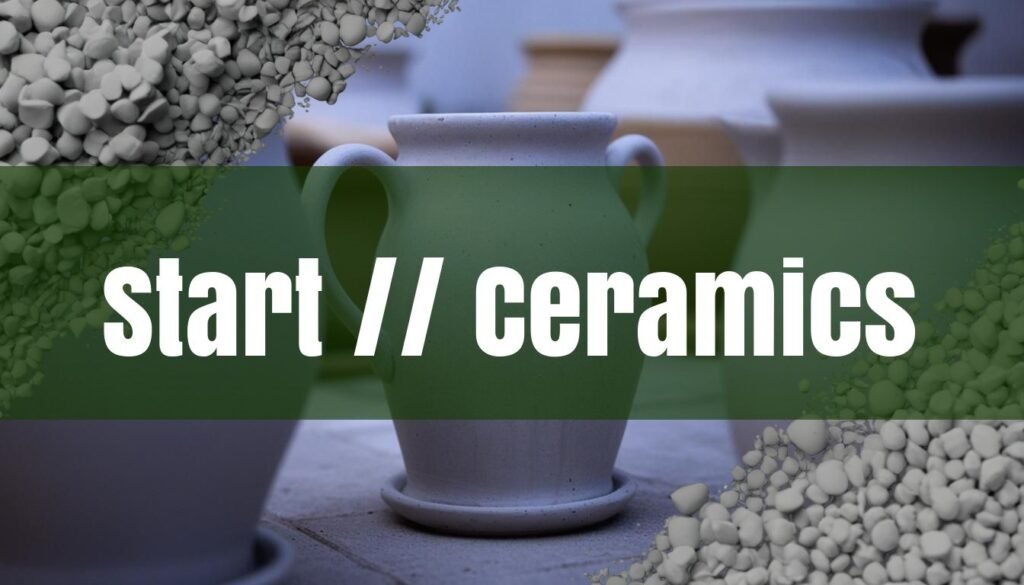So, you’re drawn to the allure of clay, the tactile satisfaction of shaping earth into art. Ceramics is a journey of creativity, patience, and a willingness to get your hands dirty. Starting can feel daunting, but with the right guidance, it can be an incredibly rewarding experience. This article will serve as your comprehensive guide, gently leading you through the essentials to begin your ceramics adventure.
Essential Tools and Equipment
Embarking on your ceramics journey requires gathering a few essential tools. The first and foremost is clay itself. There are various types of clay, each with its unique properties, and we’ll delve deeper into those later. Beyond clay, a kiln is arguably the most vital piece of equipment. A kiln is essential for firing your creations, transforming the raw clay into durable ceramic pieces, especially if you plan to make tableware, vases, or anything meant to last. Electric kilns are generally recommended for beginners due to their ease of use and consistent temperature control. Most small electric kilns can fire up to around 1280°C (The Little Pot Company).
Assuming you’re interested in wheel throwing, a pottery wheel is a significant investment. Even a small electric wheel is sufficient for a beginner (The Little Pot Company). Variable speed control is crucial, allowing you to adjust the wheel’s speed as you learn to center and shape the clay. The ability to reverse the wheel’s direction is also beneficial, especially if you find it easier to throw in a particular direction (The Little Pot Company). Beyond the wheel, a collection of hand tools will become your best friends. A cut-off wire is essential for removing your pot from the wheel after it’s formed (The Little Pot Company). Sponges, both regular and on a stick, are indispensable for wetting the clay during throwing and removing excess water from inside your pieces (The Little Pot Company). Chamois leather is perfect for smoothing the rims of your pots (The Little Pot Company). Wooden ribs are useful for shaping and smoothing the bases of plates and bowls (The Little Pot Company). Pin tools are great for cutting away wobbly tops or popping air bubbles (The Little Pot Company). A throwing stick can help clean up the outsides of pots and create an undercut bevel at the base, making it easier to remove from the wheel (The Little Pot Company). Trimming tools are necessary for refining the shape of your pots and creating footrings (The Little Pot Company). You’ll also want to invest in an apron to protect your clothing and keep some towels or rags handy for quick clean-ups (Fowlers Clayworks). Other helpful tools include a basic metal rib, wooden and rubber ribs (Susan Ohanlon Pottery), wire tools (Susan Ohanlon Pottery), a knife or two (Susan Ohanlon Pottery), a needle tool (Susan Ohanlon Pottery, Fowlers Clayworks), calipers (Fowlers Clayworks), and a good glazing brush (Susan Ohanlon Pottery).
Exploring Different Ceramic Techniques
Ceramics offers a variety of techniques to explore, each offering unique possibilities for creating different forms and textures. Hand-building techniques are a great place to start, as they require minimal equipment and allow you to directly engage with the clay. Pinch pots are the most basic hand-building method, involving inserting your thumb into a ball of clay and pinching the walls to create a small vessel (Ceramic Arts Network). This technique is excellent for developing a feel for the clay and understanding how it responds to pressure. Coil building involves rolling out long, rope-like coils of clay and layering them on top of each other to build up the walls of your piece (Ceramic Arts Network). The coils are then blended together to create a seamless form. This technique is ideal for creating larger, more complex forms (Ceramic Arts Network). Slab construction involves rolling out flat slabs of clay and then joining them together to create different shapes (Ceramic Arts Network). Slabs can be draped over molds, cut into geometric shapes, or used to create more angular, structured forms (Ceramic Arts Network). These techniques can be combined to create even more interesting and complex pieces (Ceramic Arts Network).
Wheel throwing is another popular technique that involves using a pottery wheel to shape the clay (The Little Pot Company). It requires practice and patience to master, but it allows for the creation of symmetrical, functional forms such as cups, bowls, and vases (The Little Pot Company). The basic steps of wheel throwing include centering the clay on the wheel, opening the clay to create a well, pulling up the walls of the cylinder, and shaping the form to your desired design. Remember, the most important tools are your hands, and these should be looked after (The Little Pot Company)! If you’re looking for more guidance, check out this article on essential wheel throwing techniques.
Understanding Clay, Firing, and Glazing
Understanding the properties of different types of clay is crucial for successful ceramics. The predominant types of pottery clay are earthenware, stoneware, and porcelain, but a mix of other clays to make them easier to handle may be preferable (Seattle Pottery Supply). Earthenware is a widely used clay that fires at lower temperatures, typically between 1600-2200°F (Kiln Fire). It’s easy to work with and comes in various colors, but it’s also more porous and fragile than other types of clay (Kiln Fire, Seattle Pottery Supply). Earthenware is suitable for decorative items like planters and figurines (Kiln Fire). Stoneware clays fire at higher temperatures, between 2200-2400°F, making them less porous and more durable than earthenware (Kiln Fire). Stoneware is ideal for functional pieces like tableware and cookware (Kiln Fire). Porcelain clays fire at the highest temperatures, ranging from 2200-2600°F, resulting in a very dense, non-porous, and translucent material (Kiln Fire). Porcelain is prized for its white color and delicate appearance, but it’s also more difficult to work with than stoneware or earthenware (Kiln Fire). Porcelain is often used for fine art sculptures and delicate tableware (Kiln Fire).
Firing temperatures, or heat workability, refers to the range of kiln temperatures at which the clay vitrifies or sinters to become ceramic (Kiln Fire). Higher firing ranges yield harder, denser clay with lower absorbency (Kiln Fire). Plasticity refers to a clay’s malleability and ease of shaping (Kiln Fire). Porcelain clays tend to be the most plastic, followed by stoneware and earthenware (Kiln Fire). As the clay dries, it becomes fragile in its “greenware” or unfired state (Kiln Fire). Shrinkage refers to the degree of reduction from the initial wet size to the finished fired piece (Kiln Fire).
Glazing is the process of applying a decorative and protective coating to your ceramic pieces (Susan Ohanlon Pottery). Glazes are essentially a thin layer of glass that fuses to the surface of the clay during firing. Glazes come in a wide variety of colors and finishes, allowing you to create endless effects. Understanding how different glazes react with different clays and firing temperatures is essential for achieving your desired results. A good glazing brush is essential (Susan Ohanlon Pottery). To learn more, read this article on glazing techniques for potters.
Setting Up a Studio and Finding Inspiration
Setting up a home studio can be as simple as dedicating a corner of a room to your ceramics practice. You’ll need a sturdy work surface, storage for your clay and tools, and access to water. If you don’t have space for a kiln, consider finding a local ceramics studio or community center that offers kiln firing services. Taking ceramic classes or workshops is a great way to learn new techniques, get feedback from experienced instructors, and connect with other ceramic enthusiasts. Local community centers and art organizations often have ceramics facilities with kilns available for the community to use.
Inspiration can be found everywhere, from nature to architecture to everyday objects. Look at the shapes and textures around you, and consider how you can translate them into clay. Experiment with different techniques and don’t be afraid to try new things.
Tips for Skill Development and Overcoming Challenges
Developing your skills in ceramics takes time and practice. Be patient with yourself and celebrate your progress, no matter how small. Don’t be discouraged by mistakes; they are a natural part of the learning process. Instead, analyze your mistakes and learn from them. Keep practicing, and gradually increase the complexity of your projects. It takes years to become a master in Pottery, and just like anything you learn, you can expect to make mistakes along the way (Pottery Crafters). Improper wedging can make your Clay difficult to work with or make it hard for you to center the Clay (Pottery Crafters). Not wedging correctly will introduce more air pockets rather than take them out (Pottery Crafters). Water issues are the most common mistakes made by novices and seasoned potters (Pottery Crafters). If you’re working on Clay that’s too dry and hard, you will find it almost impossible to get it centered on the Wheel, and if you do, it’s not easy to form (Pottery Crafters). On the other hand, too much water will be easy to center your Clay and just as easy for your Clay to collapse when pulling up a wall (Pottery Crafters). Please center the clay properly to avoid wobbly and uneven forms (Cerdeira Home for Creativity). Take the time to master the art of centering (Cerdeira Home for Creativity). Practice centering the clay consistently until it becomes second nature (Cerdeira Home for Creativity). A well-centered base sets the foundation for a successful pottery piece (Cerdeira Home for Creativity).
There are many simple projects perfect for beginners. Pinch pots have come a LONG way since elementary school (Pinterest). There’s something really special about displaying a bunch of fresh flowers in your own handmade vase (Gathered). Brighten up the night with your own sweet tea light candle holders (Gathered). Coil pottery is one of the easiest techniques for any new potter to try – and you don’t need a wheel to get started (Gathered)! Jewelry dishes are more interesting when they are not perfect, which is why they are a great ceramic project for those just feeling their way around (Classpop). Roll out your clay and use cookie cutters to make cute clay decorations (Gathered). Clay coasters are a great way to get kids into pottery (Gathered). Beads are a breeze to make using clay (Gathered).
Ceramics is a journey of continuous learning and exploration. Embrace the challenges, celebrate the successes, and most importantly, enjoy the process of creating with clay.





